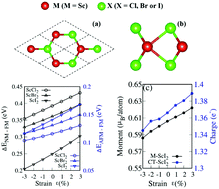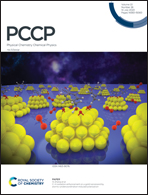First-principles investigation of ScX2 (X = Cl, Br, or I) monolayers for flexible spintronic and electronic applications†
Abstract
Two-dimensional (2D) nanomaterials with multiple characteristics are potential candidates as nanodevices for various applications. Herein, a family of 2D ScX2 (X = Cl, Br, or I) monolayers with functional properties are theoretically proposed to investigate their potential applications in spintronics and electronics. We show that these new nanomaterials possess ferromagnetic and semiconducting properties. The ScX2 monolayers hold intrinsic magnetism, which is ascribed to the ionic interaction between the Sc and X atoms. The magnetism is robust under repeated applied strains, which make them promising as flexible spintronic materials. Furthermore, we demonstrate that the ScX2 monolayers present semiconducting features and ultra-mobile carrier mobilities (∼103 cm2 V−1 s−1) benefited from their small deformation potentials. The carrier mobilities of the ScX2 monolayers are comparable with or more mobile than those of most 2D nanomaterials, which make them potential candidates as high-performance electronics. Our results suggest that the ScX2 monolayers may find various applications in flexible spintronics and electronics.



 Please wait while we load your content...
Please wait while we load your content...